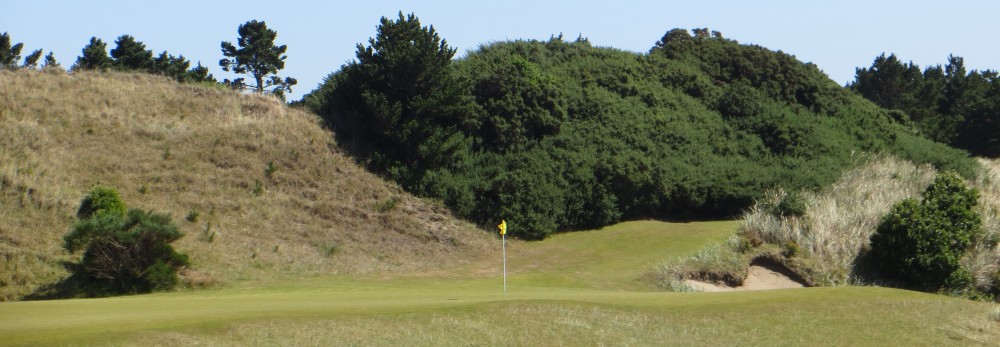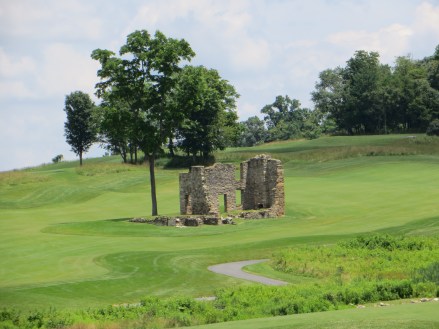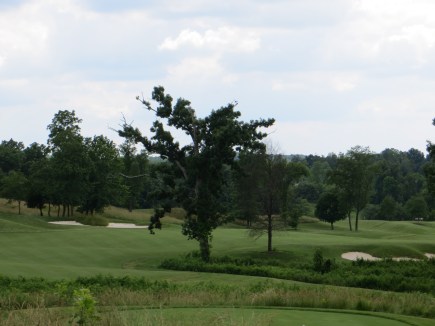
The symbiotic relationship of golf and the military is well documented and is evidenced by the fact that there are golf courses at almost every major military facility in the country. Best part is the courses are there to serve the individuals and families of those in uniform no matter their rank. The low key and humble presentation of this classic and challenging old school golf course makes for a memorable golf experience for everyone who steps on the first tee.

The Par 4 14th is typical of the day’s challenge-somewhat blind off the tee with a significant elevation adjustment required on approach.
The U.S. Naval Academy Golf Club dates back to the 1940’s and was created late in the distinguished career of the Golden Age architect William Flynn on a flowing piece of terrain close to the Naval Academy in Annapolis. The original course, having had a couple of holes added in the mid-50’s, remained as it was until Andrew Green did a thorough cosmetic renovation in 2021. He pruned back trees to open up the playing areas, relocated and rebuilt bunkering throughout to add some punitive expense to your misses, rebuilt the tees to modern standard, and reconfigured the greens to recapture lost angles and pin placements. But on balance he respectfully maintained the strategic playability of the original Flynn design.
The course is very typical of what was built in the Mid-Atlantic region in the 1940’s and 50’s. The macho formula of the day was find a high spot for the teeing ground, a low valley to receive the tee shot, and a higher spot to bench the green complex and complicate the approach. The course plays very uphill into the greens which makes a 6200 yard course play over 6500 even without any wind effect.

The 170 yard Par 3 7th has two forced carries-one over the water and one over the false front. Picking the right wrench is crucial on these short holes.
Besides all the uphill approach shots the most obvious characteristic is the complexity of the green areas. Flynn loved table top green settings and this one has more high tops then a singles bar. As a result meek approach shots are often repelled and you can wear out your 60 degree wedge on recovery shots. One thing you will find that is not original design are the moated short grass surrounds on a number of the holes with long approach shots. Green left a user friendly, close-to-the-ground option for recovery if you are a bit too aggressive into these greens.
Andrew Green expanded the putting surfaces to reclaim their original size and shape that typically wither over time. He left severe internal slopes and undulations creating segmentation to greens already steep back-to-front. This puts a premium on approach shots getting to the proper section given the pin of the day to avoid defensive putting.

Par 4 1st hole requires carry off the tee and a hoisted extra carry up the hill into the blind green.
The first hole is a template for what you will have to cope with through the day. Drive off a perched tee across the edge of a water element cordoning the right side of the fairway to an expansive landing area beyond. Now you are looking straight up a massive slope requiring a club and a half more then the distance to a blind putting surface perched behind a false front and deep bunkers. Green created a low collection area in the front left of the green behind the bunker that is a magnet for any ball aimed at a back pin without sufficient resolve. The new greens have plenty of pace in them so navigating undulations like you see on the first requires the right balance of confidence and resolve to play a game close to your index.
Memorable courses present a variety of challenges that keep the player off balance. The short, on level second, at just over 300 yards, tempts you to take a direct line to the flag but there is a sentinel oak tree in the right rough about 50 yards short of the putting surface that should dissuade you from such heroics. Lesser club played on a line well left of center gives leaves a manageable short pitch into your first coffee table of the day. From the rough or over a 60 foot oak your chances of holding this piece of furniture are slim and none.

#3 the first Par 5 seems simple from the tee but controlling the side roll on the first two shots is essential to having a birdie opportunity.
The first par five of the day is a stunning view from the tee and once again you get the formula of high tee to low landing area to high green setting, but this time the added complication of a fairway that cants sharply left-to-right on the first two shots is thrown into the mix. This last 50 yards of approach and the green are set on a plateau so there is none of that false front, sharp shoulder roll off, but the surface itself has plenty of turbulence so two-putts are not guaranteed.

One of the few truly downhill holes, the short Par 4 6th gives you an idea of how Andrew Green used variegated spacing of the bunkering to force strategic decisions off the tee.
The rest of the outward nine is open, hilly, and full of optics and challenge with your best scoring opportunities from four through seven. Eight and nine are brutally difficult long four pars so you need spending pars in the bank before you get there.

The 425 yard 8th is just plain hard but the green tucked behind the trees makes position on the left off the tee essential.
Eight may be the hardest hole of the day requiring a long carry tee shot not dissimilar to the adjacent first hole, but the approach this time is on level to a high top green arrangement tucked to the right behind a stand of trees and protected by some of the most viscous bunkers you will see all day. Take the “Pit of Death” moniker of the front right bunker seriously.
Once you traverse the long ninth make sure to stop in to the bar/restaurant under the blue awning at the base of the Naval Academy Primary School, their elementary school, on the way to the tenth tee. The cup of chicken salad, tuna sandwich, or dog at the turn you can get are delectable, cheap, and necessary, as the cloistered corridors of the inward nine take on an entirely different tone then what you have experienced so far.

Now amongst the trees on the back nine precision driving on the 10th becomes important to having an unobstructed look at the green complex.
The first three holes on the back nine are probably the most interesting variety you will face all day. As you turn the corner to the 10th tee the same hilly terrain you saw on the front nine is now encapsulated in tree lined corridors of play. The drive on the tenth has to be hit far enough right to avoid the severe camber of the fairway that can abruptly drag a timid effort back towards you into the rough forty yards to the left leaving no visual of the green. From the middle of the fairway the approach is a half a club more to a half blind green setting on top of a hill.
The short 11th switches gears suddenly with a twisting dogear left that is defined by OB right and trees left. I like the long club off the tee here that you are confident will not wander to leave the shortest approach into another blind green complex way up the hill. The bunker you can make out on the left is a good 50 yards short of the putting surface so adjust your club selection accordingly.

At 225 yards the 12th is not your grand dad’s typical Redan three-par…you don’t see one like this in a typical Seth Raynor collection.
What comes next is Andrew Green’s new hole, the most visual offering of the day. Best described as a driver/fairway wood reverse Redan par three with serious elevation parameters….now there is a mouthful. Matching left-to-right ball flight to the angle of the green setting is obvious, negotiating the downhill adjustment and the roll out of a driving club is a different kettle of fish. My conclusion is, that if in doubt, take the longer club and hit it through the green since the pitch back is a routine uphill bump and run to all pin settings.
As was true on the front side, the best scoring opportunities are in the middle holes of the back nine so control your tee ball on the next two and be aggressive on approach if you have a stock club in hand.

A solemn tribute to those who gave their lives in our effort to expand man’s knowledge through space exploration.
Walking from the 14th green to the 15th tee take a moment to engage with the tribute memorial, a reminder of the bravery of seven space explorers who lost their lives in 2003 in the Columbia Space Shuttle Disaster when the orbiter disintegrated upon reentry over Texas and Louisiana just 16 minutes from their intended touchdown. The stars in the pavers around this monument commemorate the lives of Rick Husband, William McCool, Michael Anderson, Kalpana Chawla, David Brown, Laurel Clark, and llan Ramon who were lost in this tragedy. Solidarity with the brave always has a place in a military facility.
Interesting anecdote about the monument shared by a club member. William McCool, the pilot of the Columbia, was a Navy pilot who, when he attended the Naval Academy was the captain of their cross country team. The placement of this memorial was 16 minutes from the course finish line!
(Click to read more about the story of Willie McCool)

The Par 4 15th just tumbles below your feet from the elevated tee box. Position of this tee will determine whether to take on the carry over a wall of bunkers in front or lay-up right for an up-and-down effort.
The finishing holes will test your discipline as they are all about controlled shot making to avoid blowing up your scorecard. 16 is a short par four with a blind landing area off the tee leaving a dicey approach into another bar stool green sloped back-to-front with nothing but trouble around it.

Another uphill approach into this severely sloped green on the short 16th.
The signature hole in this run is the pitch n putt 17th, a steeply downhill Par 3 which simulates landing a short iron on the hood of a VW Beetle. The view from the tee is disarming in that this is literally a lawn dart hole, there are no good misses here. If you miss the green playing for four is just smart.

17th green does not present much safe harbor so figure the downhill and the wind and commit to the middle of the putting surface.
The 18th is the modest twin sister of the 9th just across the entrance drive, but you must drive the ball in play to have any hope of hitting this green and walking off the hole with a gratifying par. If you are out of position off the tee lay up in front of the putting surface for a little elevation pitch to today’s pin.
As I said at the beginning, there is nothing flamboyant or tricky about the presentation of this old school course. Having to hit a club or more extra into many of these Par 4’s will tax your patience and strategic discipline. I am pretty sure that walking off the 18th green the first thought you will have is that you need another crack at this one. That is the sure sign of a course worth going out of your way to play.
Annapolis, Maryland
Architect: William Flynn (1944) and Andrew Green (2021)
Par Rating Slope Yardage
Blue 70 71.2 126 6610
White 70 69.6 121 6200
Red 72 69.0 120 4935
(Click to review the printable Naval Academy Course hole-by-hole descriptions)






























